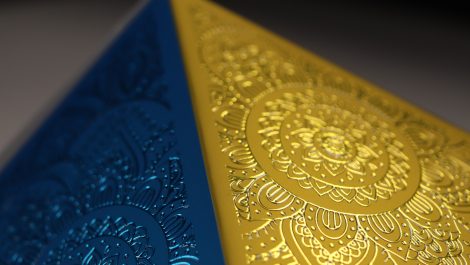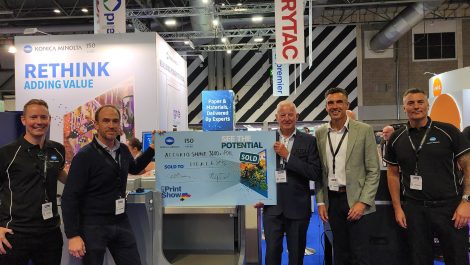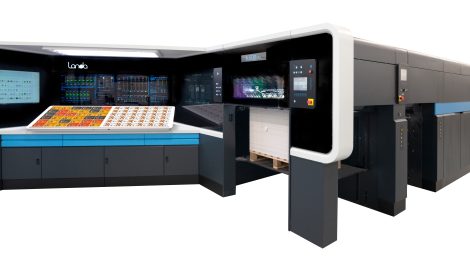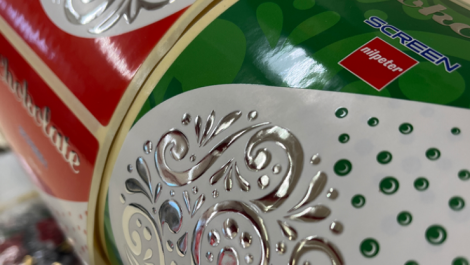After a decade in development, MGI has launched the AlphaJet B1 digital printing and embellishment press, aiming at both commercial and packaging applications for the single-pass digital CMYK print, UV varnish and foil machine.
Previously slated for launch at drupa 2020, the €3 million press combines what have previously been separate print and finishing processes into one, saving on both floorspace and staffing, requiring only a single operator, according to MGI co-founder, executive vice-president and managing director Victor Abergel, who discussed the AlphaJet’s genesis and gestation in some detail prior to a live production demonstration at Konica Minolta’s Industrial Digital Printing facility in Paris.
Described by MGI as ‘a single-pass Factory 4.0’, the AlphaJet uses 1600 x 1600dpi Memjet printheads and MGI/KM’s own aqueous inks and UV-curable varnish, plus a variety of foils, including holographic and cast-and-cure types, to offer a full production of dry and finishing-ready embellished sheets at the rate of 1800 simplex sheets per hour. Media support ranges from 135gsm paper to 2000-micron board and some synthetic and metallised types are supported, though may need priming first for ink adhesion.
The CMYK inks are said to cover 80% of the Pantone range and to be Fogra-certified within this. At the moment there are no firm plans to increase the number of inks, though Mr Abergel told Digital Printer that any such move would most likely see the addition of two further primary colours, such as green and blue, to optimise gamut expansion, rather than just the addition of a fifth colour.
The UV ‘varnish’ options include flood (with satin or gloss finish options), spot, ‘tactile’ (2D) and textural (3D, up to a maximum build height of 200 microns), all of which can be mixed within a sheet as desired, subject to suitable layer information being available in the artwork PDF. Foiling will then follow the contours of the UV.
Registration accuracy was a key design goal for the AlphaJet. Eschewing cylindrical designs and belt transports, the press uses flatbed imaging on trays that effectively float and are moved via electromagnetic repulsion, removing pretty well all possible sources of friction. Vibration is further minimised by mounting the print section on a 4.5 tonne granite block. The whole press weighs 20 tonnes, and including 4000-sheet input and output stackers, occupies 150sqm in a looped configuration, but requires 200sqm for all-round access and paper loading/removal.
Press control is via a three-screen ‘flight deck’ which combines operational dashboard displays for overall equipment efficiency (OEE) with production status and 3D rendering software that enables print items to be previewed, shared and approved remotely for production, including modelling the visual effects of embellishment. The Cloud-based software also allows remote monitoring and even production control via tablet. Stock profiles can be set up and loaded to facilitate job changes, a process that was said to take two or three minutes, including loading of the material.
Sustainability also figured in MGI’s design deliberations. In addition to claiming a 30% smaller energy requirement and a 60% reduction in overall carbon footprint compared to separate print and embellishment processes, Mr Abergel confirmed that the inks, UV varnish and foils used in the AlphaJet are all de-inkable according to Ingede criteria, meaning that AlphaJet print should be fully recyclable along with most analogue print types. Perhaps equally important is the argument that by using the UV flood coating, which can be a thin as three microns, plastic lamination can be avoided entirely, which Mr Abergel said had attracted considerable interest from packaging printers working for luxury brand owners looking to improve their environmental credentials.
In terms of applications, the combined print and embellishment combined with the B1 format and substrate range is a natural fit for high quality shorter-run cartons and Mr Abergel told Digital Printer that at least one large European analogue packaging printer is considering the machine and has set up a ‘secret’ digital department to evaluate it and understand the workflow required.
On the commercial side the case is perhaps less immediately clear, but Mr Abergel gave the example of a loyalty cards printed by first AlphaJet customer ISRA, for whom the ability to go plastic-free had been a major attraction. High quality business cards and personalised high-end marketing materials are other possibilities, as are some industrial applications, including printed electronics. Mr Abergel also pointed out that the machine can embellish-only and thus could handle offset printed sheets with equal facility.
The AlphaJet is available to order now and a second demonstration centre is to be opened at Konica Minolta’s New York, USA facility.





